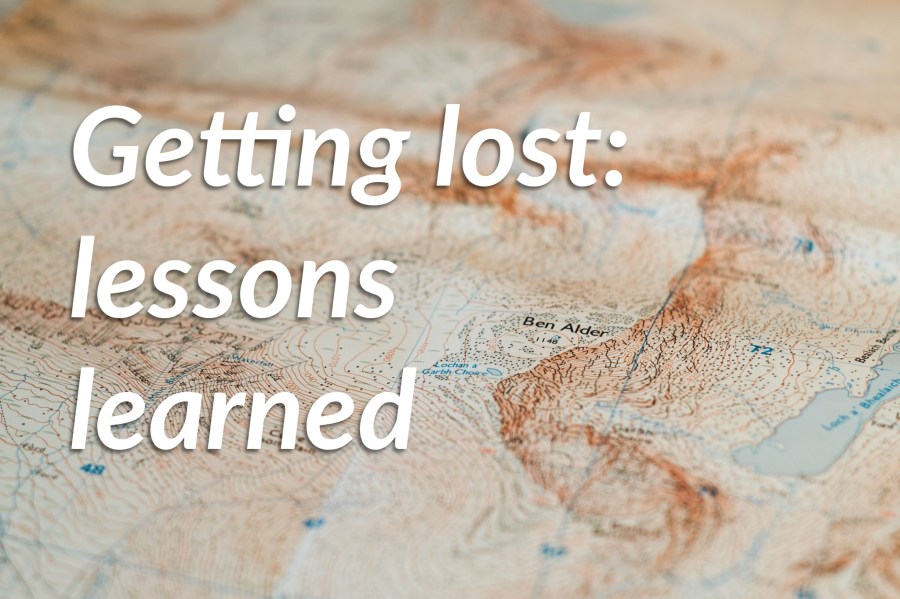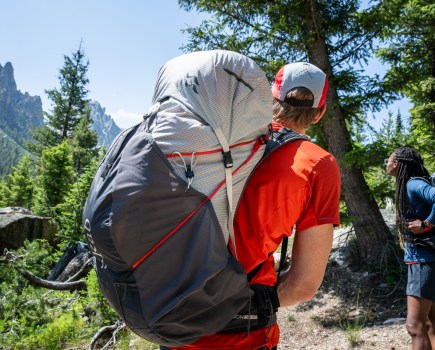“When lost, your worst enemy is yourself. Despite checking bearings several times, we all still look around, check the map and think: No, that can’t be right, it’s the other way.”
This is part of our series of reader submissions on getting lost and lessons learned the hard way. To read more entries, and to find out how to submit your own, see this page.
Keith Foskett is a long-distance hiker, author, and outdoor writer. Visit his website at keithfoskett.com to read his blog or learn more about his books.
An extended version of this story was first published here.
One December I was out with some friends on my local hills, the South Downs. This walk is a yearly tradition between mates, a fifteen-miler stopping at a couple of pubs and catching up with people I sometimes don’t see for 12 months.
It was 5pm, getting dark, and low cloud swirled around us. Our field of vision stopped abruptly where our torch beams gave up as a fence appeared in the murk. We were on a footpath, at a modest elevation, doing a walk that we’d completed many times before.
What could go wrong?
I was up front, looking forward to a teacake and cup of Earl Grey at the Singing Kettle Café, two miles distant. I slowed, as I do each year at the same place because I always forget the direction. I turned to Ted, a route veteran.
“We have to take a right somewhere around here, yeah?” I said doubtfully.
“Yes,” he replied. “Next one, next right.”
I reached the turn, looked back at Ted for verification – to which he nodded – and we all turned right. No one questioned it, despite everyone’s familiarity with our route. Ten minutes further on and I turned to my best mate Jeremy.
“This isn’t right.”
“No, it’s not,” he replied.
“It may sound obvious but you cannot get lost if you know where you are”
We reached a steel gate with an unwelcoming white sign.
‘Private Land – No right of Way’
Clearly we had taken a wrong turn and just needed to retrace our steps back up the hill. But we’d become disorientated. Someone disappeared into the bushes amidst mumbles of “This looks right”.
“This looks right” soon turned out to be completely wrong.
We convened at the gate for a discussion. No one had a map or compass and perhaps only three of us were familiar with them anyway. There was a SatNav device on offer but, again, no one knew how to use it, including the owner.
It may sound obvious but you cannot get lost if you know where you are. This advice was drilled into me many times by my tutor a few years ago on a navigation course while descending Scafell Pike in the Lake District. His point was simple, always concentrate on the location through regular checks on the map and landmarks. If you know where you are, then the bearing and distance to the next checkpoint are easy. If you don’t, especially in mist and dark (one of the worst combinations), then it has the potential to be downright dangerous.
As head torches swept around, mutterings intensified and stubble was scratched. It dawned that we were lost.
Soon, the expected “Let’s try up here”, or “It’s this way” surfaced. Some waved iPhones around helplessly and, indeed, our little village flashed a mere 40 minutes’ walk to the east. Despite a majority verdict in Apple’s favour I disappointed them by asking what was between us and our destination, according to the screen. Blank looks all round.
“Your iPhone won’t tell you about the possible lake, dense forest or cliff face in between,” I told them.
“Have faith in the compass and believe the choice you have made. Take some time to learn how to use a map and compass, and indeed a satellite navigation device”
Silence. I asked for the SatNav, which was duly handed over. I didn’t own one and wasn’t confident using it, but it seemed user-friendly. A red dot signalled our location, which I confirmed by a brief walk up the hill as said dot responded by plotting a line. A bridleway about half a mile away linked with a footpath which, in turn, descended to cake and tea. I walked off, letting everyone know about my rumbling stomach and that my directions were correct, despite mutterings to the contrary.
We reached a field and I checked the SatNav again, confirming the course. Crossing the field, I looked to my right; a long stream of head torches swept around like a search party, looking for the path.
It appeared in front of me. I re-checked the screen, and noted a sharp incline ahead which finished near – hopefully – familiar surroundings. I turned right, started to climb and sure enough we reached an intersection that everyone recognised, confirmed by the lights of the village a few hundred feet below us. Fifteen minutes later and were steaming up windows and stirring cups of tea.
When lost, your worst enemy is yourself. Despite checking bearings several times, we all still look around, check the map and think: No, that can’t be right, it’s the other way.
Trust your decision was the other piece of advice my navigation guide taught me. Have faith in the compass and believe the choice you have made. Take some time to learn how to use a map and compass, and indeed a satellite navigation device.
I still doubt my abilities when navigating; instinct is a powerful force that is difficult to ignore. If in doubt, I check, then check again and go with it.
Stay safe.
Read more in our reader series ‘Getting lost: lessons learned the hard way’









